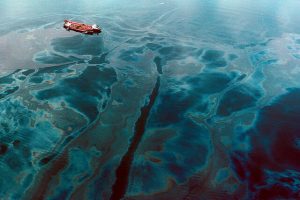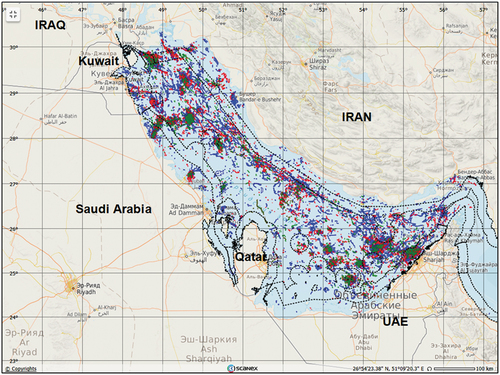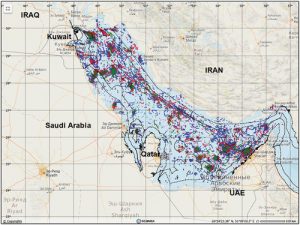Explore the environmental impact of oil spills in the Persian Gulf. Learn how political tensions, tanker routes, and ecological damage intersect in one of the world’s most critical maritime regions.

From oil slicks to trawling: Persian Gulf under pressure, Credit: https://www.tehrantimes.com/news/472224/From-oil-slicks-to-trawling-Persian-Gulf-under-pressure
Why Oil Spills in the Persian Gulf Matter to Global Maritime Operations
The Persian Gulf is more than a vital artery for the global energy trade—it is also an ecological treasure. Hosting over 40% of the world’s proven oil reserves, this shallow, semi-enclosed sea sees thousands of tanker movements annually. Yet, behind the economic significance lies a growing environmental challenge: oil spills.
Oil pollution in the Persian Gulf is not just a local issue—it has global consequences. Marine biodiversity, fisheries, coastal tourism, and international shipping safety are all at stake. According to the International Maritime Organization (IMO), even small chronic oil leaks in sensitive marine areas like the Gulf can result in long-term damage to coral reefs, mangroves, and fish populations.
In a world aiming for cleaner oceans and sustainable shipping, understanding the environmental cost of oil spills in the Persian Gulf is essential for policymakers, maritime professionals, and environmental advocates alike.
The Unique Vulnerability of the Persian Gulf Ecosystem
What makes the Persian Gulf especially vulnerable to oil spills is a combination of geographical, ecological, and geopolitical factors.
Geography: A Semi-Enclosed, Shallow Sea
Unlike deep ocean basins that can disperse pollutants, the Persian Gulf is only about 35 meters deep on average and has restricted water exchange with the Gulf of Oman through the narrow Strait of Hormuz. This means oil tends to stay trapped within the Gulf, accumulating along coastlines and seabeds.
Biodiversity Under Threat
Despite harsh conditions—high salinity, extreme heat—the Gulf supports a surprising variety of marine life. Key habitats include:
-
Mangroves in Qatar and the UAE, essential for carbon sequestration.
-
Coral reefs around Bahrain, crucial for biodiversity.
-
Seagrass beds, which serve as nurseries for fish and shrimp.
The Marine Pollution Bulletin (2021) reports that even light crude oil can cause lethal stress to coral larvae within hours of exposure, while heavy crude can smother mangrove roots, leading to ecosystem collapse.
The Persian Gulf is characterized by a huge number of offshore oil and gas platforms, large number of many oil terminals, and busy shipping lines for supporting oil transportation. In this regard, developing various methods for assessing the oil pollution of the Gulf, including remote sensing, is extremely important. For the first time, synthetic aperture radar (SAR) images of the European Sentinel-1A and Sentinel-1B satellites were used routinely to monitor the entire Gulf in 2017–2019.
Sources and Frequency of Oil Spills in the Gulf
Chronic Operational Spills
Not all oil spills are headline-grabbing disasters. Routine tanker operations—ballast discharge, engine waste, and pipeline leaks—contribute to what scientists call “chronic oil pollution.” These smaller, persistent discharges often go unnoticed but cause cumulative environmental degradation.
A 2023 study published in Ocean Engineering found that over 100,000 tons of petroleum hydrocarbons enter the Gulf annually, mostly from regular shipping operations and refineries.
Major Spill Incidents
Though rare, major oil spill incidents in the Gulf have caused devastating consequences. One of the most severe occurred during the 1991 Gulf War, when retreating Iraqi forces deliberately dumped over 1 million barrels of oil into the sea, primarily off the Kuwaiti and Saudi coasts. It remains the largest intentional oil spill in history, and its effects are still being studied.
Satellite imagery and sediment samples analyzed by the United Nations Environment Programme (UNEP) show that the area’s benthic ecosystems have yet to fully recover, even three decades later.
Political Risk Factors
In the last 5 years, the risk of oil spills due to sabotage or geopolitical tension has increased. Tanker attacks in 2019 near the Strait of Hormuz raised alarm over both crew safety and environmental fallout. Though no catastrophic spills occurred, they served as a chilling reminder of what could happen if a laden VLCC (Very Large Crude Carrier) were ruptured.
Real-World Case Studies: Oil Spill Disasters and Lessons Learned
1991 Gulf War Spill – A Man-Made Disaster
During the Gulf War, retreating Iraqi forces opened valves at the Sea Island Terminal, dumping oil into the Gulf as a military tactic. The resulting spill covered over 6,000 square kilometers of the ocean surface.
According to a joint study by NOAA and UNEP, the environmental consequences included:
-
Death of over 25,000 seabirds
-
Loss of 80% of coral coverage in the affected areas
-
Severe impact on green and hawksbill turtle nesting beaches
2020 Ras Tanura Oil Leak
In 2020, a minor leak from an undersea pipeline off Saudi Arabia’s Ras Tanura port led to several kilometers of oil sheen. While controlled swiftly, local fisheries suffered a 15% drop in catch volume that month, as reported by the Saudi Environmental Authority.
This incident led to increased monitoring using drone surveillance and satellite imaging, showcasing the Gulf states’ growing adoption of remote sensing technologies for marine pollution control.
Challenges and Solutions in Spill Prevention and Response
Lack of Unified Regional Protocols
One major hurdle is the absence of a Gulf-wide oil spill contingency plan. While countries like the UAE and Saudi Arabia have their own response units, coordination across borders is limited.
A 2022 report by the International Tanker Owners Pollution Federation (ITOPF) notes that fragmented legal frameworks and slow information sharing often delay response times.
Outdated Response Equipment
Not all Gulf states have kept pace with modern oil spill response gear. Skimmers, booms, and dispersants are not always readily available in remote coastal areas.
To address this, the Regional Organization for the Protection of the Marine Environment (ROPME) is working to establish shared emergency depots and training programs in collaboration with DNV and Wärtsilä.
New Technologies Offer Hope
Recent innovations include:
-
Autonomous surface drones that can detect and localize slicks in real-time.
-
Bio-remediation techniques, where oil-eating microbes are deployed to accelerate breakdown.
-
AI-powered satellite systems developed by companies like Orbital Insight for early detection and predictive modeling.
The UAE has also partnered with Thetius and Equasis to develop a smart shipping corridor where vessels are required to report ballast discharge digitally, increasing traceability.
Future Outlook: Can the Gulf Become an Oil Spill-Resilient Region?
Despite ongoing risks, the future isn’t bleak. Gulf states are increasingly embracing international maritime regulations, technological innovation, and regional cooperation.
International Collaboration
Saudi Arabia, Bahrain, and the UAE have all ratified MARPOL Annex I, which deals specifically with oil pollution. Oman and Qatar are also working with the IMO and EMSA to modernize their compliance systems.
More promising is the Gulf’s growing alignment with the UN’s Sustainable Development Goal 14—“Life Below Water”—which mandates reducing marine pollution by 2025.
Green Shipping Transitions
Cleaner fuels, like LNG and hydrogen, are being explored for regional tankers and port operations. The 2024 edition of Maritime Economics & Logistics highlights a feasibility study for LNG bunkering hubs in Fujairah and Ras Laffan, which could drastically reduce operational oil leakage.
Furthermore, BIMCO and ICS are encouraging their members operating in the Gulf to adopt zero-discharge policies and use oil-water separators with real-time logging.
Frequently Asked Questions (FAQ)
What causes most oil pollution in the Persian Gulf?
Chronic operational discharges—such as from tanker ballast and refinery runoff—are the leading causes, not large-scale accidents.
Why is oil pollution worse in the Persian Gulf compared to open seas?
Because it’s a semi-enclosed, shallow sea with limited circulation, oil tends to linger longer and impact local ecosystems more severely.
Which countries are most active in oil spill response in the Gulf?
The UAE, Saudi Arabia, and Qatar have the most advanced response infrastructure, though ROPME is trying to coordinate efforts regionally.
How does oil pollution affect marine life in the Gulf?
It harms coral reefs, kills seabirds, disrupts fish breeding, and contaminates mangrove ecosystems—many of which are already under stress from climate change.
What are the latest technologies being used to detect oil spills?
AI-based satellite imaging, autonomous marine drones, and microbial remediation are among the latest tools.
Can oil spills affect shipping and port operations?
Yes. Oil-covered waters pose a risk to hulls, propellers, and cooling systems, sometimes forcing rerouting or port closures.
What international laws apply to oil spills in the Gulf?
MARPOL Annex I, OPRC (Oil Pollution Preparedness, Response and Cooperation Convention), and UNCLOS are all applicable frameworks.
Conclusion: Protecting the Gulf, Protecting Global Trade
The Persian Gulf is a paradox—a region vital to energy exports and shipping logistics, yet highly vulnerable to the very resource it supplies. Oil spills here are not just environmental disasters; they are logistical, economic, and humanitarian crises waiting to unfold.
From intentional wartime spills to accidental pipeline leaks, each incident leaves a scar on the Gulf’s fragile ecosystems. But with the right mix of technology, cooperation, and regulation, this region can become a model for oil spill preparedness.
For students, policymakers, and professionals in the maritime sector, the Persian Gulf offers a vital lesson: clean seas and secure trade go hand in hand.
References
-
International Maritime Organization (IMO). (2023). MARPOL Annex I and Oil Pollution Regulations. Link
-
UNEP. (2022). Environmental Legacy of the Gulf War Oil Spill. Link
-
Marine Pollution Bulletin. (2021). Oil Spill Impact on Coral Reefs in the Gulf.
-
ROPME. (2023). Regional Marine Emergency Response Framework.
-
DNV. (2023). Oil Spill Risk Assessments in the Middle East. Link
-
Ocean Engineering Journal. (2023). Petroleum Hydrocarbon Load in the Gulf.
-
ITOPF. (2022). Oil Spill Preparedness in Developing Economies. Link
-
Wärtsilä. (2023). Smart Port Pollution Detection Systems. Link
-
BIMCO. (2024). Zero Discharge Policy Guidelines. Link
-
Equasis. (2024). Vessel Pollution Records and Port State Control Data. Link
-
Thetius. (2023). Maritime Innovation and Environmental AI. Link
-
Maritime Economics & Logistics. (2024). Green Shipping Corridors in the Middle East.


